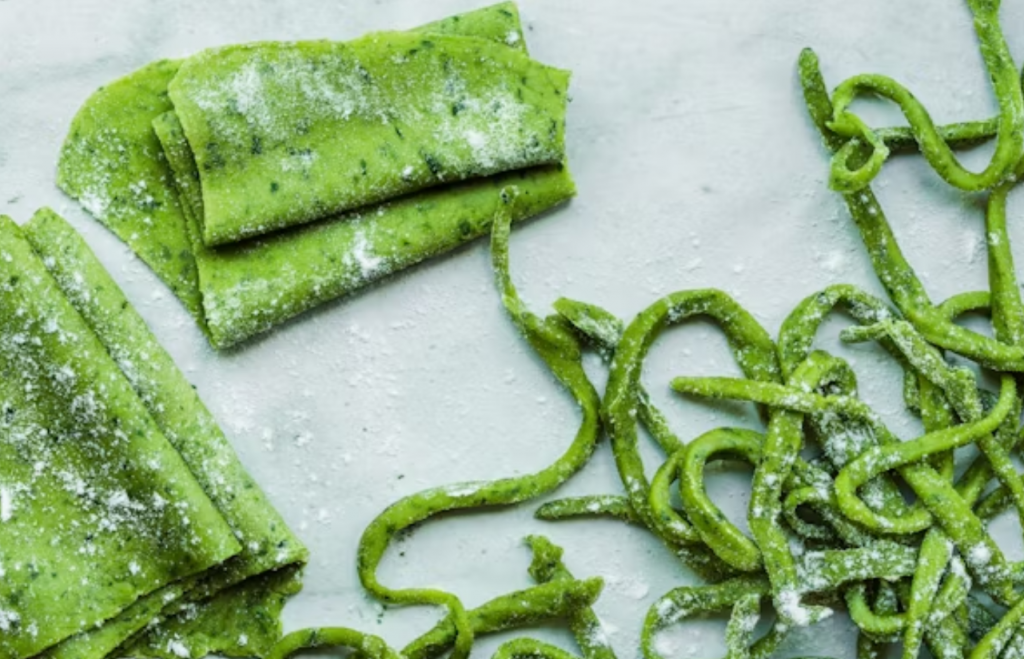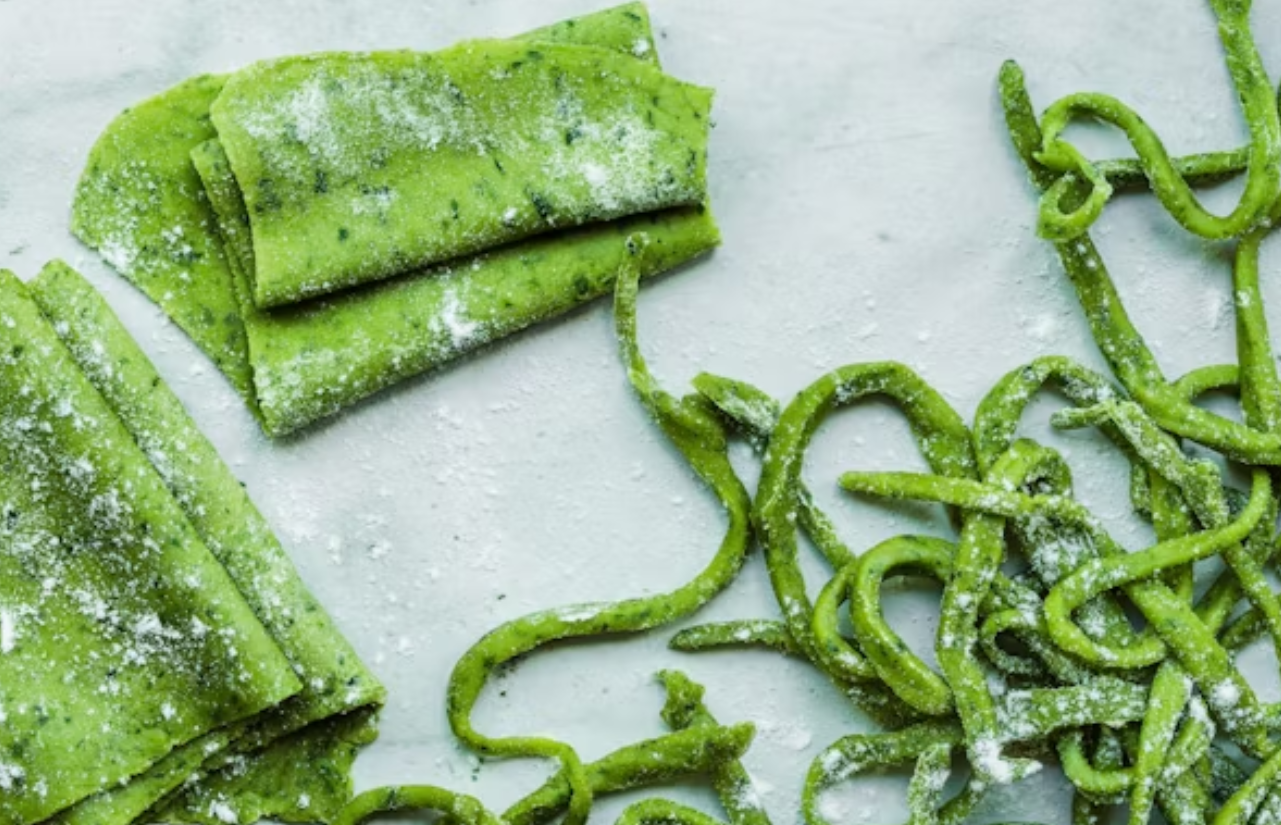Introduction
In today’s world, people are increasingly looking for ways to reduce their carb intake while still enjoying satisfying, flavorful meals. Enter zucchini noodles, also known as “zoodles” – a low-carb, gluten-free alternative to traditional pasta. When paired with a rich, fragrant pesto sauce, zucchini noodles transform into a delicious, nutrient-packed dish that can be enjoyed by those following low-carb, keto, or even vegan diets. In this article, we’ll walk you through how to make zucchini noodles with pesto from scratch and why this dish is a must-try.

Why Choose Zucchini Noodles?
The Low-Carb Advantage
Zucchini noodles are a great choice for anyone looking to cut back on carbs. Traditional pasta is high in carbohydrates, but zucchini noodles are incredibly low in calories and carbs, making them a fantastic option for those on a low-carb or keto diet. With just a few simple ingredients, you can create a dish that mimics the texture and feel of pasta without all the carbs.
Health Benefits of Zucchini
Zucchini is a powerhouse vegetable packed with vitamins, minerals, and antioxidants. It’s an excellent source of vitamin C, potassium, and fiber, all of which help boost your immune system, improve heart health, and aid digestion. Zucchini is also low in calories, which makes it an ideal vegetable for weight management.
Ingredients You’ll Need
Zucchini
The main ingredient for this recipe is, of course, zucchini. Choose fresh, firm zucchini without any blemishes. You’ll need about two medium zucchinis for a single serving of zoodles, but you can adjust the quantity based on how many people you’re serving.
Pesto Ingredients
For the pesto, you’ll need fresh basil, garlic, pine nuts (or walnuts), Parmesan cheese (optional for vegan pesto), olive oil, and salt. You can also add a little lemon juice for an extra kick of freshness. If you’re following a vegan or dairy-free diet, simply leave out the Parmesan and replace it with nutritional yeast for a cheesy flavor.
The Tools for the Job
Spiralizer
To make zucchini noodles, you’ll need a spiralizer. This handy tool turns your zucchini into perfect, curly noodles in just seconds. If you don’t have a spiralizer, you can use a vegetable peeler or a mandoline slicer, but the spiralizer is by far the easiest and most efficient tool.
Food Processor
For making the pesto, a food processor or a high-speed blender is essential. It helps blend all the ingredients into a smooth, creamy consistency. You’ll also need a spatula to scrape down the sides to ensure everything is evenly mixed.
How to Make Zucchini Noodles
Step-by-Step Process
- Spiralize the Zucchini: Use your spiralizer to create the zucchini noodles. If you prefer thicker or thinner noodles, adjust the spiralizer’s settings accordingly.
- Cook the Zucchini Noodles: You have a couple of options here. You can either sauté them in a pan with a little olive oil for 2-3 minutes or simply blanch them in boiling water for a minute or two. Be careful not to overcook the noodles, as they can turn soggy quickly.
- Drain and Pat Dry: If you’ve cooked the zucchini noodles, make sure to drain any excess water. Zucchini has a high water content, so drying them ensures they won’t make your pesto watery.
Tips for Perfect Zucchini Noodles
- Avoid overcooking the noodles. Zucchini noodles cook quickly, so keep an eye on them.
- If you prefer a firmer texture, opt for a quick sauté over boiling.
- To avoid sogginess, consider salting the noodles lightly and letting them sit for a few minutes before cooking to draw out excess moisture.
How to Make Pesto from Scratch
Classic Basil Pesto Recipe
To make traditional pesto, blend together 1 cup of fresh basil leaves, 2 cloves of garlic, ¼ cup of pine nuts (or walnuts), and ½ cup of Parmesan cheese (optional). Slowly drizzle in ½ cup of olive oil while the food processor runs until the mixture reaches a creamy, smooth consistency. Season with salt and pepper to taste.
Variations for Different Tastes
If you want to experiment, you can try variations of pesto, such as:
- Spinach Pesto: Add spinach to the mix for a milder, earthy flavor.
- Kale Pesto: For a hearty twist, substitute kale for basil.
- Vegan Pesto: Omit the Parmesan and use nutritional yeast for that cheesy flavor.
Combining Zucchini Noodles with Pesto
Once your zucchini noodles are ready, it’s time to toss them with the freshly made pesto. Pour the pesto over the noodles and mix gently until the noodles are evenly coated. The creamy texture of the pesto pairs perfectly with the light, crisp zucchini noodles, creating a refreshing and satisfying dish.
Serving Suggestions
Pairing with Protein
To make your meal more filling, add some grilled chicken, shrimp, or even tofu. These proteins complement the freshness of the zucchini noodles and make the dish more balanced.
Additional Toppings for Extra Flavor
Add a sprinkle of crushed red pepper flakes for a touch of heat, or a drizzle of balsamic glaze for some tanginess. You can also top the dish with extra Parmesan cheese, pine nuts, or fresh basil leaves for added flavor and texture.
Health Benefits of Zucchini Noodles with Pesto
Low-Carb, Keto-Friendly, and Nutrient-Dense
Zucchini noodles are a perfect low-carb, keto-friendly option. Combined with the healthy fats from olive oil and pine nuts in the pesto, this dish provides essential nutrients while keeping the carb count low.
A Heart-Healthy Meal
Pesto is made with olive oil, which is rich in monounsaturated fats, promoting heart health. Zucchini provides fiber and antioxidants, which help reduce inflammation and support cardiovascular health.
Common Mistakes to Avoid
Overcooking Zucchini Noodles
Zucchini noodles cook quickly, and overcooking them can lead to a mushy texture. Aim for a quick sauté or blanching to keep them firm and al dente.
Incorrect Pesto Consistency
If your pesto is too thick, you can thin it out with a little extra olive oil. If it’s too runny, try adding more nuts or cheese to thicken it.
How to Store Leftovers
Proper Storage Tips for Zucchini Noodles
Zucchini noodles should be stored in an airtight container in the fridge for up to 2 days. Avoid storing them with excess moisture to prevent sogginess.
Storing Pesto for Future Use
Pesto can be stored in the fridge for up to a week or frozen for longer storage. If you plan to freeze it, ice cube trays work great for portioning out small amounts.
Variations and Substitutions
Vegan or Dairy-Free Pesto
For a vegan pesto, simply omit the cheese and substitute with nutritional yeast. You can also experiment with other nuts or seeds, like sunflower seeds, if you’re looking for a different flavor.

No responses yet